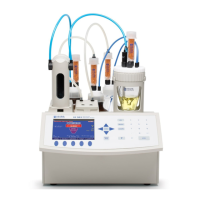26
TITRATION THEORY
6 GLOSSARY
Acid
A chemical species that can donate one or more protons (hydrogen ions).
Acid-Base Titration
Stoichiometric neutralization titrations, based upon the reaction that occurs between
an acid and base.
Activity
A physical property corresponding to the concentration of all ions in a solution. Elec-
trodes respond to activity.
Amperometric Titration
Titrations where the current flow between two electrodes (often a metal electrode and
a reference electrode) are used to monitor the titration progress.
Analyte
The chemical species being measured in a titration.
Argentometric Titration
Titrations that use silver (nitrate) as the titrant. These titrations are typically precipita-
tion titrations.
Automatic Titrator
An instrument designed to automatically carry out a titration. It will add the appro-
priate amount of titrant, determine the end-point and calculate the results.
Back Titration
A type of titration where an excess amount of titrant is added to a sample forcing a
sluggish reaction to go to completion. The excess reagent is then “back” titrated with
a second titrant.
Base
A chemical species that can accept one or more protons (hydrogen ions).
Biamperometric Indication
Uses a double platinum pin electrode to measure the current flow through a
titration solution.
Bivoltametric Indication
Uses a double platinum pin electrode to measure the voltage required to maintain a
constant current flow through a titration solution while constant voltage is applied
across the platinum elements of the electrode
Burette
A graduated cylindrical piece of laboratory glassware that is used to dispense precise
amounts of solution.
Complex Ion
A species where a central metal ion is covalently bonded to one or more electron
donating groups called ligands.
Complexometric Titrations
Metal ions are titrated using a titrant that binds strongly to it. The titrants often
contain Ethylenediaminetetraacetic Acid (EDTA) or Cyclohexylenedinitrilotetraacetic
Acid (CDTA).

